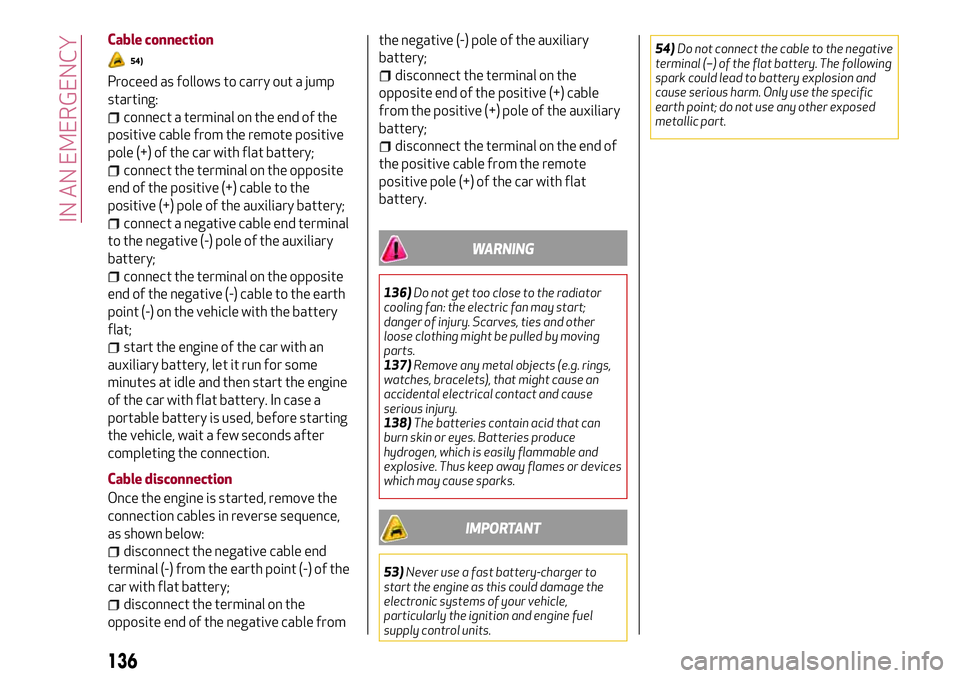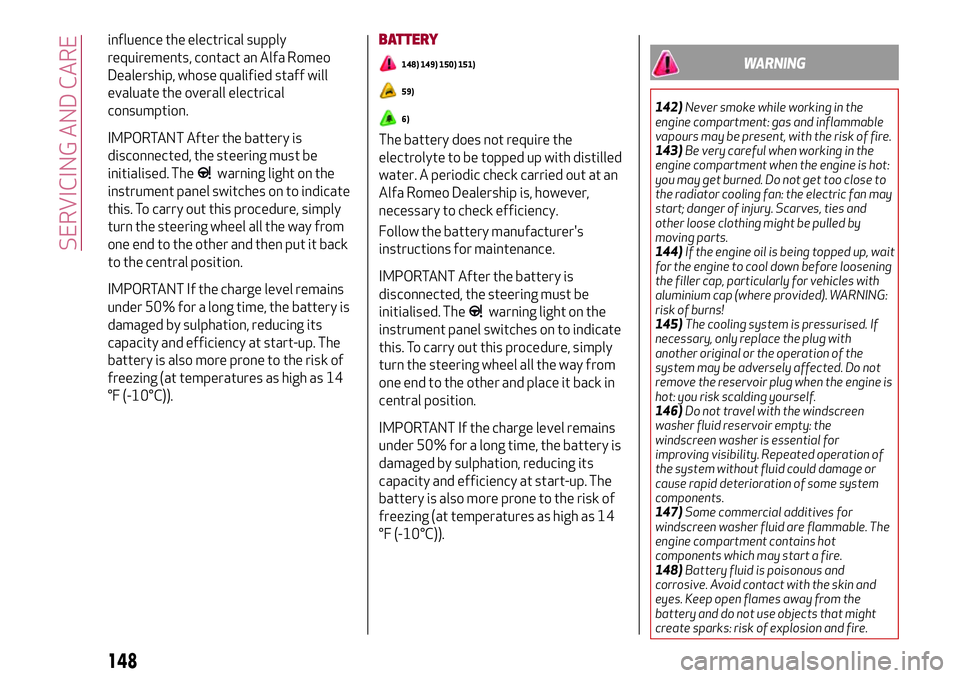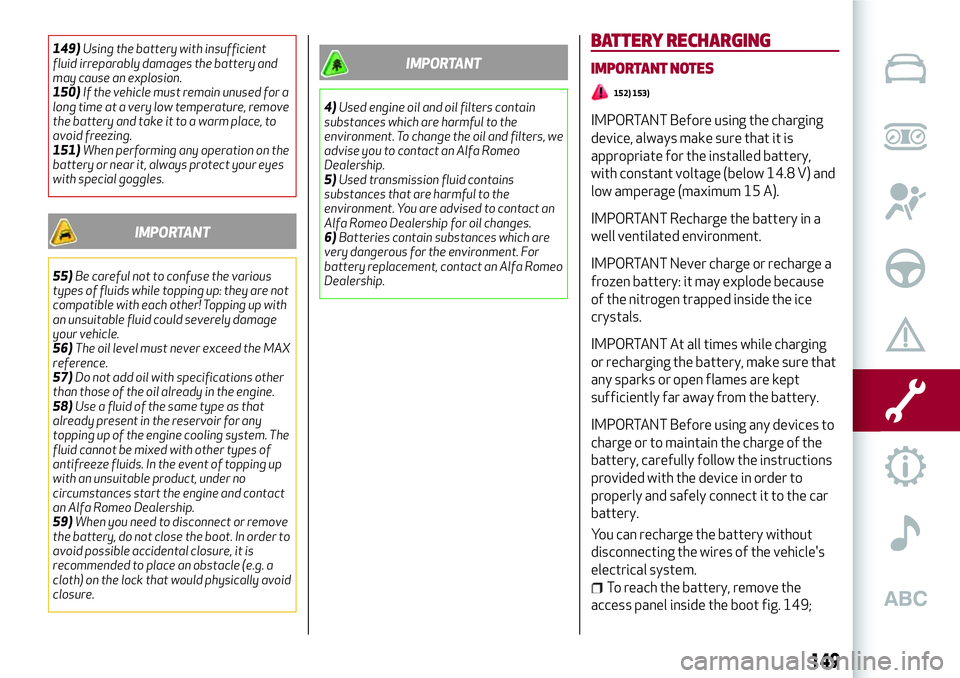2016 Alfa Romeo Giulia cooling
[x] Cancel search: coolingPage 33 of 204

Air flow to the windscreen and front
side window vents to
demist/defrost them.
Air flow at central and side
dashboard vents to ventilate the
chest and the face during the hot
season.
Air flow to the front and rear
footwell vents. This air distribution
setting heats the passenger
compartment most quickly, giving a
prompt sensation of warmth.
Air flow distributed between
footwell vents (hotter air) and
central and side dashboard vents
(cooler air). This air distribution
setting is useful in spring and
autumn on sunny days.
Air flow distributed between
footwell vents and windscreen and
front side window defrosting/
demisting vents. This distribution
setting allows the passenger
compartment to be warmed up
efficiently and prevents the
windows from misting up.
Air flow distribution between
windscreen demisting/defrosting
vents and side and central
dashboard vents. This allows air to
be sent to the windscreen in
conditions of strong sunlight.
Air flow distribution to all diffusers
on the vehicle.
In AUTO mode, the air conditioner
automatically manages the air
distribution. When set manually, the air
distribution is indicated by the respective
symbols on the Connect system display
switching on.
START & STOP EVO
The automatic dual zone climate control
system interacts with the Start & Stop
Evo system (engine off when vehicle
speed is 0 mph (0 km/h)) to ensure
adequate comfort inside the vehicle.
In particular, the climate control system
deactivates the Start & Stop Evo if:
the climate control system is in AUTO
mode (LED on the button switched on)
and the temperature conditions inside
the vehicle are far from a comfort
temperature;
the climate control system is in LO for
maximum cooling;
the climate control system is in the
MAX-DEF status.
With Start & Stop Evo system on (engineoff and vehicle speed equal to 0 mph
(0 km/h)), the flow is reduced as much as
possible, to keep the compartment
comfort conditions for longer.
IMPORTANT
2)The system uses R1234yf coolant gas,
which does not pollute the environment in the
event of accidental leakage. Under no
circumstances use R134a and R12 fluids,
which are incompatible with the components
of the system.
31
Page 138 of 204

Cable connection
54)
Proceed as follows to carry out a jump
starting:
connect a terminal on the end of the
positive cable from the remote positive
pole (+) of the car with flat battery;
connect the terminal on the opposite
end of the positive (+) cable to the
positive (+) pole of the auxiliary battery;
connect a negative cable end terminal
to the negative (-) pole of the auxiliary
battery;
connect the terminal on the opposite
end of the negative (-) cable to the earth
point (-) on the vehicle with the battery
flat;
start the engine of the car with an
auxiliary battery, let it run for some
minutes at idle and then start the engine
of the car with flat battery. In case a
portable battery is used, before starting
the vehicle, wait a few seconds after
completing the connection.
Cable disconnection
Once the engine is started, remove the
connection cables in reverse sequence,
as shown below:
disconnect the negative cable end
terminal (-) from the earth point (-) of the
car with flat battery;
disconnect the terminal on the
opposite end of the negative cable fromthe negative (-) pole of the auxiliary
battery;
disconnect the terminal on the
opposite end of the positive (+) cable
from the positive (+) pole of the auxiliary
battery;
disconnect the terminal on the end of
the positive cable from the remote
positive pole (+) of the car with flat
battery.
WARNING
136)Do not get too close to the radiator
cooling fan: the electric fan may start;
danger of injury. Scarves, ties and other
loose clothing might be pulled by moving
parts.
137)Remove any metal objects (e.g. rings,
watches, bracelets), that might cause an
accidental electrical contact and cause
serious injury.
138)The batteries contain acid that can
burn skin or eyes. Batteries produce
hydrogen, which is easily flammable and
explosive. Thus keep away flames or devices
which may cause sparks.
IMPORTANT
53)Never use a fast battery-charger to
start the engine as this could damage the
electronic systems of your vehicle,
particularly the ignition and engine fuel
supply control units.54)Do not connect the cable to the negative
terminal (–) of the flat battery. The following
spark could lead to battery explosion and
cause serious harm. Only use the specific
earth point; do not use any other exposed
metallic part.
136
IN AN EMERGENCY
Page 150 of 204

influence the electrical supply
requirements, contact an Alfa Romeo
Dealership, whose qualified staff will
evaluate the overall electrical
consumption.
IMPORTANT After the battery is
disconnected, the steering must be
initialised. The
warning light on the
instrument panel switches on to indicate
this. To carry out this procedure, simply
turn the steering wheel all the way from
one end to the other and then put it back
to the central position.
IMPORTANT If the charge level remains
under 50% for a long time, the battery is
damaged by sulphation, reducing its
capacity and efficiency at start-up. The
battery is also more prone to the risk of
freezing (at temperatures as high as 14
°F (-10°C)).BATTERY
148) 149) 150) 151)
59)
6)
The battery does not require the
electrolyte to be topped up with distilled
water. A periodic check carried out at an
Alfa Romeo Dealership is, however,
necessary to check efficiency.
Follow the battery manufacturer's
instructions for maintenance.
IMPORTANT After the battery is
disconnected, the steering must be
initialised. The
warning light on the
instrument panel switches on to indicate
this. To carry out this procedure, simply
turn the steering wheel all the way from
one end to the other and place it back in
central position.
IMPORTANT If the charge level remains
under 50% for a long time, the battery is
damaged by sulphation, reducing its
capacity and efficiency at start-up. The
battery is also more prone to the risk of
freezing (at temperatures as high as 14
°F (-10°C)).
WARNING
142)Never smoke while working in the
engine compartment: gas and inflammable
vapours may be present, with the risk of fire.
143)Be very careful when working in the
engine compartment when the engine is hot:
you may get burned. Do not get too close to
the radiator cooling fan: the electric fan may
start; danger of injury. Scarves, ties and
other loose clothing might be pulled by
moving parts.
144)If the engine oil is being topped up, wait
for the engine to cool down before loosening
the filler cap, particularly for vehicles with
aluminium cap (where provided). WARNING:
risk of burns!
145)The cooling system is pressurised. If
necessary, only replace the plug with
another original or the operation of the
system may be adversely affected. Do not
remove the reservoir plug when the engine is
hot: you risk scalding yourself.
146)Do not travel with the windscreen
washer fluid reservoir empty: the
windscreen washer is essential for
improving visibility. Repeated operation of
the system without fluid could damage or
cause rapid deterioration of some system
components.
147)Some commercial additives for
windscreen washer fluid are flammable. The
engine compartment contains hot
components which may start a fire.
148)Battery fluid is poisonous and
corrosive. Avoid contact with the skin and
eyes. Keep open flames away from the
battery and do not use objects that might
create sparks: risk of explosion and fire.
148
SERVICING AND CARE
Page 151 of 204

149)Using the battery with insufficient
fluid irreparably damages the battery and
may cause an explosion.
150)If the vehicle must remain unused for a
long time at a very low temperature, remove
the battery and take it to a warm place, to
avoid freezing.
151)When performing any operation on the
battery or near it, always protect your eyes
with special goggles.
IMPORTANT
55)Be careful not to confuse the various
types of fluids while topping up: they are not
compatible with each other! Topping up with
an unsuitable fluid could severely damage
your vehicle.
56)The oil level must never exceed the MAX
reference.
57)Do not add oil with specifications other
than those of the oil already in the engine.
58)Use a fluid of the same type as that
already present in the reservoir for any
topping up of the engine cooling system. The
fluid cannot be mixed with other types of
antifreeze fluids. In the event of topping up
with an unsuitable product, under no
circumstances start the engine and contact
an Alfa Romeo Dealership.
59)When you need to disconnect or remove
the battery, do not close the boot. In order to
avoid possible accidental closure, it is
recommended to place an obstacle (e.g. a
cloth) on the lock that would physically avoid
closure.
IMPORTANT
4)Used engine oil and oil filters contain
substances which are harmful to the
environment. To change the oil and filters, we
advise you to contact an Alfa Romeo
Dealership.
5)Used transmission fluid contains
substances that are harmful to the
environment. You are advised to contact an
Alfa Romeo Dealership for oil changes.
6)Batteries contain substances which are
very dangerous for the environment. For
battery replacement, contact an Alfa Romeo
Dealership.
BATTERY RECHARGING
IMPORTANT NOTES
152) 153)
IMPORTANT Before using the charging
device, always make sure that it is
appropriate for the installed battery,
with constant voltage (below 14.8 V) and
low amperage (maximum 15 A).
IMPORTANT Recharge the battery in a
well ventilated environment.
IMPORTANT Never charge or recharge a
frozen battery: it may explode because
of the nitrogen trapped inside the ice
crystals.
IMPORTANT At all times while charging
or recharging the battery, make sure that
any sparks or open flames are kept
sufficiently far away from the battery.
IMPORTANT Before using any devices to
charge or to maintain the charge of the
battery, carefully follow the instructions
provided with the device in order to
properly and safely connect it to the car
battery.
You can recharge the battery without
disconnecting the wires of the vehicle's
electrical system.
To reach the battery, remove the
access panel inside the boot fig. 149;
149
Page 167 of 204

REFUELLING
2.2 JTD engine
Fuel tank (UK gal / litres) 11.44 UK gal (52 lt)
including a reserve
of (UK gal / litres) 1.76 UK gal (8 lt)
Engine cooling system (UK gal / litres) 1.72 UK gal (7.8 lt)
Engine sump and filter (UK gal / litres) 0.79 UK gal (3.6 lt) (RWD Version) / 0.88 UK gal (4 lt) (AWD Version)
Hydraulic brake circuit (UK gal / litres) 0.20 UK gal (0.9 lt)
Windscreen washer fluid reservoir (UK gal / litres) 0.92 UK gal (4.2 lt)
Automatic transmission, 2.2 JTD 180 HP RWD engine (UK gal / litres) 2.02 UK gal (9.2 lt)
Automatic transmission, 2.2 JTD 210 HP AWD engine (UK gal / litres) 2.00 UK gal (9.1 lt)
GETRAG G217 manual gearbox (UK gal / litres) 0.31 UK gal (1.4 lt)
RDU 230-LSD differential (UK gal / litres) 0.20 UK gal (0.9 lt)
RDU 210-eLSD differential (if present) (litres) 0.31 UK gal (1.4 lt)
RDU 210/215-LSD differential (UK gal / litres) 0.24 UK gal (1.1 lt)
AWD System FAD transfer case (UK gal / litres) 0.11 UK gal (0.5 lt)
AWD System TRANSFER CASE (UK gal / litres) 0.15 UK gal (0.7 lt)
165